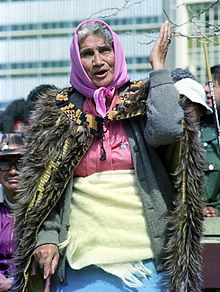- Whina Cooper
-
Whina Cooper 
Whina Cooper addressing the Māori Land March at Hamilton in 1975Born Hohewhina Te Wake
9 December 1895
Te Karaka, HokiangaDied 26 March 1994 (aged 98)
PanguruNationality  New Zealand
New ZealandDame Whina Cooper ONZ DBE (9 December 1895 – 26 March 1994), was born Hohewhina Te Wake, daughter of Heremia Te Wake of the Te Rarawa iwi, at Te Karaka, Hokianga,
From an early age she showed an interest in her father’s role, as well as in history and genealogy. She worked as a teacher for a brief time, but stirred on by a local land dispute, developed a taste for a form of home-spun politics, including passive resistance. She played a leading role in community activities, impressing politician Sir Apirana Ngata who invited her to a national hui in 1932. She worked alongside him to promote Māori land development programmes in the Hokianga.
Cooper moved to Auckland in 1949 when her second husband died, and her political activity changed from local to national. In September 1951 she was elected first president of the new Māori Women's Welfare League.[1] The league's success was largely due to her efforts, and she became well-known throughout the country. In 1957 she stepped down as president and the annual conference rewarded her with the title Te Whaea o te Motu ("Mother of the Nation").
During the 1960s Whina Cooper worked on a local level around Auckland, but, with declining health, she kept largely out of the national spotlight. This changed in 1975 when a coalition of Māori groups asked her to lead them in a protest against the loss of Māori land. She agreed, proposing a hikoi - a symbolic march from the northern tip of the North Island to Parliament in Wellington at the other end of the island. During September and October 1975, the nearly 80-year-old Whina Cooper again became nationally recognised, walking at the head of the Māori land march from Te Hapua to Wellington. She was made a Dame Commander in the Order of the British Empire in 1981 and a member of the Order of New Zealand in 1991.
Death
Whina Cooper returned to Panguru in the Hokianga in 1983 and died there, aged 98, in 1994.
Sources
- ^ Ministry for Culture and Heritage (6). "Dame Whina Cooper". http://www.nzhistory.net.nz/people/dame-whina-cooper. Retrieved 17 April 2011.
- King, Michael (2003). Cooper, Whina 1895 - 1994 (biography of Dame Whina Cooper)
External links
- Whina Cooper biography from the Dictionary of New Zealand Biography
- Te Matakite O Aotearoa - The Maori Land March - Full-length documentary about the 1975 march, featuring interviews with Whina Cooper on NZ On Screen
Categories:- 1895 births
- 1994 deaths
- Dames Commander of the Order of the British Empire
- Māori activists
- Members of the Order of New Zealand
- New Zealand activists
- New Zealand dames
- New Zealand schoolteachers
- People from the Northland Region
Wikimedia Foundation. 2010.
